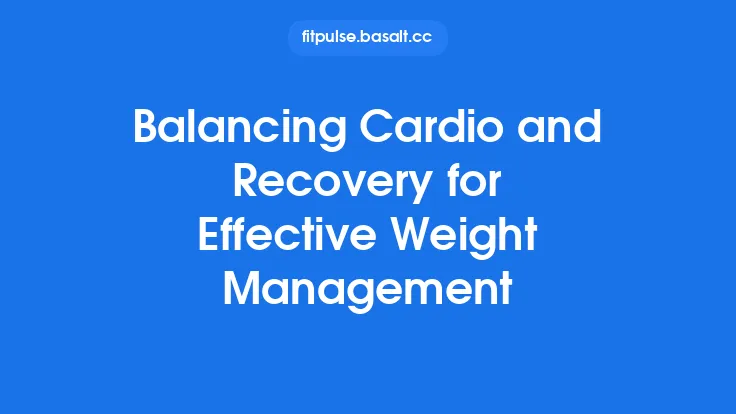Running is a cumulative sport—each stride adds a tiny bit of stress, and each recovery day allows a tiny bit of repair. The art of “optimizing weekly mileage” lies in mastering that balance: enough volume to drive physiological adaptations, but enough recovery to let those adaptations solidify. Below is a deep dive into the concepts, tools, and practical steps you can use to fine‑tune your weekly mileage for sustained progress, regardless of whether you’re training for a 10 km, a half‑marathon, or an ultra‑distance event.
Understanding Training Volume and Its Impact
Training volume is most commonly expressed as the total distance you run in a given week. While the number itself is simple, the physiological ripple effects are complex:
| Physiological Response | How Volume Influences It |
|---|---|
| Aerobic Base Development | Repeated low‑to‑moderate intensity miles stimulate mitochondrial biogenesis, capillary density, and fat‑oxidation pathways. |
| Muscular Endurance | Cumulative loading of the slow‑twitch fibers improves their oxidative capacity and fatigue resistance. |
| Cardiovascular Adaptations | Stroke volume and plasma volume expand with consistent mileage, lowering resting heart rate. |
| Running Economy (Long‑Term) | Repeated exposure to the same stride mechanics refines neuromuscular efficiency, even if the article does not focus on short‑term economy drills. |
| Hormonal & Metabolic Shifts | Chronic volume elevates basal levels of anabolic hormones (e.g., testosterone, IGF‑1) while moderating cortisol spikes when recovery is adequate. |
The key takeaway: volume is the primary driver of endurance capacity, but it only works when the body is given the chance to adapt.
Key Principles for Setting Your Weekly Mileage
- Start with a Baseline
- Current Average: Calculate the mean mileage of the past 2–4 weeks. This is your starting point.
- Consistency Factor: If you’ve been running irregularly, aim for a “steady‑state” baseline (e.g., 30 km/week) before adding spikes.
- Apply the 10 % Rule Conservatively
- Traditional wisdom suggests a 10 % weekly increase, but research shows that many athletes can tolerate slightly more if they incorporate “step‑back” weeks. A safe approach is 8 % growth for three weeks, followed by a 20 % reduction (cut‑back week) to consolidate gains.
- Consider Your Training Age
- Novice (0–2 years): 30–50 km/week is often sufficient for continued improvement.
- Intermediate (2–5 years): 60–90 km/week can yield noticeable performance jumps.
- Advanced (5+ years): 100 km/week or more may be required, but only if recovery systems are robust.
- Align Mileage with Goal Race Distance
- A common guideline: Peak weekly mileage ≈ 1.5–2 × your target race distance (in km) for marathoners, but this is a rough estimate. The relationship is not linear; quality work (tempo, intervals) becomes increasingly important as mileage climbs.
- Factor in Life Stressors
- Work hours, travel, family obligations, and sleep quality all affect how much mileage you can sustainably handle. Use a “stress‑adjusted mileage” calculator:
`Adjusted Mileage = Baseline Mileage × (1 – Stress Index)`, where Stress Index ranges from 0 (no stress) to 0.3 (high stress).
Designing a Balanced Weekly Structure
A well‑structured week distributes volume across days, intersperses intensity, and embeds recovery. Below is a flexible template that can be customized for any training level.
| Day | Primary Focus | Sample Distance (km) | Intensity Notes |
|---|---|---|---|
| Monday | Recovery / Easy | 8–12 | < 65 % of max HR, conversational pace |
| Tuesday | Quality (Tempo / Cruise) | 10–14 | 20‑30 min at lactate threshold (≈ 85 % HRmax) |
| Wednesday | Mid‑week Easy + Strides | 8–12 | Easy run + 6 × 100 m strides for neuromuscular freshness |
| Thursday | Interval / Speed | 10–16 | 5 × 1 km at 5K pace with 2‑min jog recovery |
| Friday | Rest or Active Recovery | 0–5 | Optional light cross‑activity (e.g., cycling) |
| Saturday | Long Run (Endurance) | 18–30 | Steady aerobic pace, progressive build‑up |
| Sunday | Easy / Cut‑Back | 8–12 | Reduced volume, focus on form and relaxed effort |
Key design principles:
- Front‑Loading vs. Back‑Loading: Some athletes prefer a heavier early‑week load (front‑loaded) while others favor a larger weekend volume (back‑loaded). Choose the pattern that aligns with your work schedule and personal energy peaks.
- Intensity Distribution: Keep high‑intensity sessions (tempo, intervals) to no more than 20 % of total weekly mileage. This protects against excessive neuromuscular fatigue.
- Long Run Placement: The long run is the cornerstone of volume. Position it after a rest day (Friday) to maximize freshness, but ensure a recovery day follows (Sunday) to prevent cumulative fatigue.
Monitoring Load and Fatigue
Subjective and objective metrics help you decide whether to stick to the plan, push forward, or pull back.
- Rate of Perceived Exertion (RPE)
- After each run, rate effort on a 1–10 scale. A rising trend (e.g., 6 → 8) at the same pace signals accumulating fatigue.
- Heart Rate Variability (HRV)
- Daily morning HRV readings provide a window into autonomic balance. A consistent drop of > 5 % from baseline may warrant a mileage reduction.
- Training Impulse (TRIMP)
- Multiply duration (minutes) by a weighting factor based on heart‑rate zone. Summing TRIMP across the week gives a quantitative load score. Aim for a 10–15 % week‑to‑week variance to stay within a safe adaptation window.
- Performance Benchmarks
- Periodically run a “benchmark” (e.g., 5 km time trial). If times stall or regress while mileage climbs, you may be overreaching.
- Well‑Being Questionnaires
- Simple daily checklists (sleep quality, muscle soreness, mood) can flag hidden stressors before they manifest as injury.
Implementing Recovery Strategies
Recovery is not a passive state; it’s an active process that can be optimized.
- Sleep Hygiene
- Aim for 7–9 hours of uninterrupted sleep. Prioritize a consistent bedtime, limit blue‑light exposure, and consider short naps (20 min) after particularly hard sessions.
- Hydration & Electrolyte Balance
- Even though nutrition is a separate deep‑dive topic, maintaining fluid balance supports cellular repair. A simple rule: urine should be light yellow; adjust intake based on sweat rate.
- Active Recovery
- Low‑intensity activities (easy cycling, swimming, yoga) increase blood flow without adding significant mechanical stress, accelerating metabolite clearance.
- Compression & Mobility Work
- Graduated compression socks or sleeves can improve venous return during long runs. Incorporate dynamic mobility drills (leg swings, hip circles) post‑run to preserve range of motion.
- Periodical “Full Rest” Days
- At least one complete rest day per week is essential, especially after a high‑volume long run. This is when glycogen stores replenish and micro‑damage repairs.
Adjusting Mileage for Life and Performance Fluctuations
Your training calendar will inevitably intersect with work deadlines, travel, illness, or seasonal changes. Here’s a systematic way to adapt without derailing progress:
- Identify the Disruption Window
- Short‑term (≤ 1 week) vs. medium‑term (2–4 weeks) vs. long‑term (> 4 weeks).
- Apply the “Mileage Swap” Method
- Replace a planned long run with two moderate runs (e.g., 15 km + 12 km) spread across the week, preserving total volume but reducing single‑session stress.
- Utilize “Micro‑Periodization”
- Within a disrupted week, keep the intensity ratio (high‑intensity mileage ÷ total mileage) constant, but lower the absolute numbers. This maintains the stimulus while respecting recovery needs.
- Plan “Recovery Blocks”
- After a series of high‑stress weeks (e.g., a race taper or a heavy training block), schedule a 2‑week recovery block: reduce mileage by 30 % and eliminate all intervals, focusing on easy runs and mobility.
- Leverage “Cross‑Training” Sparingly
- If running is impossible (e.g., due to weather), substitute with low‑impact cardio that matches the aerobic demand (e.g., rowing at 60 % HRmax). Keep the session duration similar to the missed run to preserve the training stimulus.
Common Pitfalls and How to Avoid Them
| Pitfall | Why It Happens | Countermeasure |
|---|---|---|
| “Mileage Madness” – Adding too much too fast | Excitement after a good race or a new PR. | Stick to the 8 % growth rule and schedule mandatory cut‑back weeks. |
| Skipping Easy Days | Belief that “hard work only” yields results. | Remember that easy runs constitute ~ 70 % of total mileage for optimal adaptation. |
| Ignoring Fatigue Signals | Overreliance on the schedule rather than body feedback. | Use RPE, HRV, and sleep quality as daily decision tools. |
| Long Run Too Fast | Trying to “train race pace” on the long run. | Keep long runs 1–2 % slower than marathon pace; speed work belongs elsewhere. |
| Inconsistent Weekly Structure | Variable work hours or travel. | Build a “core” three‑day structure (e.g., Tuesday, Thursday, Saturday) that you can always fit, and fill the rest flexibly. |
| Neglecting Recovery Modalities | Assuming rest is “doing nothing.” | Schedule active recovery, mobility, and sleep hygiene as non‑negotiable items on the calendar. |
Putting It All Together: A Sample Weekly Mileage Blueprint
Below is a concrete example for an intermediate runner targeting a 30 km race in 12 weeks. The plan demonstrates progressive overload, built‑in recovery, and monitoring cues.
| Week | Total Mileage (km) | Key Sessions | Recovery Focus |
|---|---|---|---|
| 1 | 55 | 10 km tempo (Tue), 12 km long (Sat) | HRV baseline, 8 h sleep |
| 2 | 60 (+ 9 %) | 8 × 800 m intervals (Thu), 14 km long (Sat) | Post‑long‑run foam roll |
| 3 | 66 (+ 10 %) | 12 km steady (Tue), 16 km long (Sat) | Light bike 30 min (Fri) |
| 4 | 53 (‑ 20 % cut‑back) | 8 km easy (Mon), 10 km easy (Thu) | Full rest Sun, HRV check |
| 5 | 72 (+ 36 %) | 10 km tempo (Tue), 18 km long (Sat) | Compression socks during long run |
| 6 | 78 (+ 8 %) | 6 × 1 km intervals (Thu), 20 km long (Sat) | Yoga 20 min (Wed) |
| 7 | 85 (+ 9 %) | 14 km steady (Tue), 22 km long (Sat) | Sleep extension (9 h) |
| 8 | 68 (‑ 20 % cut‑back) | 10 km easy (Mon), 12 km easy (Thu) | HRV up, adjust next week |
| 9 | 90 (+ 32 %) | 12 km tempo (Tue), 24 km long (Sat) | Ice bath post‑long run |
| 10 | 95 (+ 5 %) | 8 × 800 m intervals (Thu), 26 km long (Sat) | Active recovery swim 30 min |
| 11 | 80 (‑ 16 % taper) | 10 km easy (Mon), 12 km easy (Thu) | Focus on sleep, carb‑light meals |
| 12 | 45 (Race week) | 5 km shake‑out (Tue) | Full rest 48 h before race |
How to use the blueprint:
- Track mileage daily in a log or app.
- Record RPE and HRV each morning.
- Adjust any week by ± 5 % if fatigue markers rise.
- Celebrate cut‑back weeks as essential “growth” periods.
Final Thoughts
Optimizing weekly mileage is less about chasing a specific number and more about mastering the dynamic equilibrium between stress (volume, intensity) and recovery (sleep, nutrition, low‑intensity work). By establishing a solid baseline, applying measured progressive overload, structuring your week with purposeful distribution, and continuously monitoring both objective and subjective signals, you create a feedback loop that drives steady, injury‑free improvement.
Remember:
- Volume fuels endurance, but recovery fuels adaptation.
- Consistency beats occasional spikes; a modest, well‑recovered increase each week compounds over months.
- Data informs decisions—use RPE, HRV, and TRIMP as your compass, not just the calendar.
With these principles in place, you’ll be equipped to fine‑tune your mileage, stay resilient through life’s inevitable disruptions, and keep moving forward toward your running goals. Happy miles!





